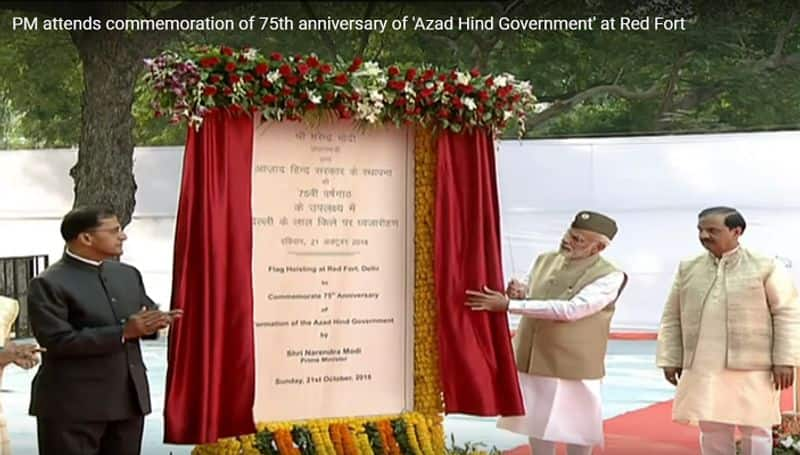However, the task of the Narendra Modi government will not be complete without taking the full measures to rehabilitate Netaji Subhas Chandra Bose in his full glory. Most importantly, bringing a closure to the mystery of Netaji’s disappearance in collaboration with countries that possibly hold post-1945 secrets such as Russia, Japan and the United Kingdom
The unfurling of the tricolour and laying of the foundation stone of a new Netaji museum by Prime Minister Modi has generated a heated debate. While the initiatives have been much appreciated by common folks, Modi’s opponents have claimed that these are nothing but politically motivated measures with an aim to appropriate the legacy of Netaji, which, till now, had been monopolised by the Congress and, to some extent, the regional political outfit Forward Bloc.
It doesn’t require a genius to comprehend that, for seven decades, none of the post-independence governments in India have given the due that Netaji Subhas Chandra Bose truly deserved. Given his stature and the deep roots in the public mind, which has kept his image alive with utmost fondness due to his inspirational public career, obliterating his memory would have been in fact impossible. Therefore, successive governments run by a forever wary Congress have cautiously done the minimum — keeping Netaji at the margins and footnotes. A statue here, a postage stamp there dotted with occasional memorials, always careful not to let his tremendous charisma and achievements eclipse the party stalwarts who negotiated India’s freedom with the British Raj. The meticulous brand building around the ahimsa of Mahatma Gandhi and the inevitability of his chosen successor (and thereafter his own successors) took care not to bring to the fore the alternative worldview of Netaji, which often stood in contrast to the outlook of these leaders.
This was accompanied with extensive spying for more than two decades after independence on the family of Netaji and others who corresponded with the family, including former INA soldiers, scholars, politicians, ordinary citizens and even foreigners who showed interest in Netaji. At the same time, over a thousand files related to Netaji and the INA were kept secret as long as the Congress government stayed in power. The official history of the INA, which was commissioned at the time of Jawaharlal Nehru, remained unpublished and beyond the access of common citizens. The standard line taken by the Congress governments against declassification of Netaji files was that such a step would harm India’s relations with foreign countries and that they would cause serious unrest within the country.
The measures initiated by the Narendra Modi government must be viewed in this backdrop. Although the Modi government took the same line against declassification in its early days as the preceding UPA government, it changed its view within a year. In October 2015, the Prime Minister announced that all files related to Netaji would be declassified and put in the public domain. Starting in January 2016, the government has until now declassified more than 300 files and placed them in an easily accessible website.
Modi’s commemoration of the establishment of the Provisional Government of Free India (Ārzī Hukūmat-e-Āzād Hind) and his announcement of celebrating Netaji’s takeover of the Andaman and Nicobar Islands in December this year is also a refreshing break from the past.
The Congress and the other opposition parties, including the CPI(M), have responded by pointing out to the supposedly friendly relations and mutual respect between Netaji and the Congress top brass that continued even as Netaji fought in Germany and south-east Asia. The defence of the INA by Congress leaders, especially the donning of the black gown by Pandit Nehru, is cited as an example of their mutual bonhomie. These, of course, run counter to historical facts, but when have historical facts stood in the way of publicity?
The fact remains that an actual act of appropriating Netaji’s legacy is much more difficult and complex than hurling accusations of doing so. The way India’s politics in aligned today, no single party can claim his legacy: an icon like him towers miles above any partisan interest. Yet, it cannot be denied that there is an obvious element of politics behind Modi’s moves. The important thing is that it is not essentially bad or wrong. Modi has done something that should have been done decades ago. He must, therefore, be congratulated irrespective of his political objectives.
At this stage, it can only be said that it has been a good beginning. The next few months will make it clear whether Modi will stop by being happy only with poking the Congress and its past inglorious chapter, or he will walk the talk by completing the full task.
That task will not be complete without taking the full measures to rehabilitate Netaji in his full glory. Among others that would include declassifying all remaining files, completing the official history of the INA and, most importantly, bringing a closure to the mystery of Netaji’s disappearance — if needed, in collaboration with countries that possibly hold post-1945 secrets such as Russia, Japan and the United Kingdom. Accomplishing these also hold out a potential conflict between a number of BJP’s icons and Netaji, that will need deft handling. Whether and how Modi achieves that before May next year needs to be seen.
A final judgement will have to wait until then.
Last Updated Oct 21, 2018, 8:03 PM IST











![Salman Khan sets stage on fire for Anant Ambani, Radhika Merchant pre-wedding festivities [WATCH] ATG](https://static-ai.asianetnews.com/images/01hr1hh8y86gvb4kbqgnyhc0w0/whatsapp-image-2024-03-03-at-12-24-37-pm_100x60xt.jpg)
![Pregnant Deepika Padukone dances with Ranveer Singh at Anant Ambani, Radhika Merchant pre-wedding bash [WATCH] ATG](https://static-ai.asianetnews.com/images/01hr1ffyd3nzqzgm6ba0k87vr8/whatsapp-image-2024-03-03-at-11-45-35-am_100x60xt.jpg)



